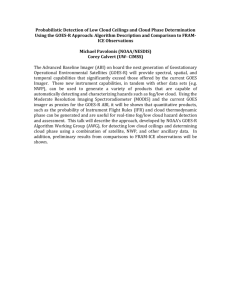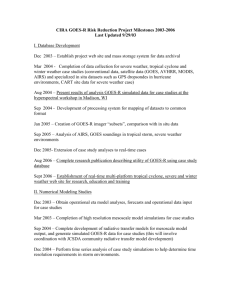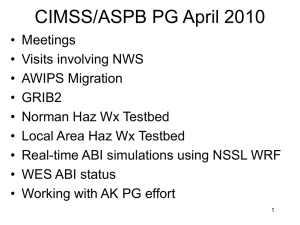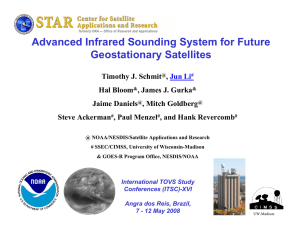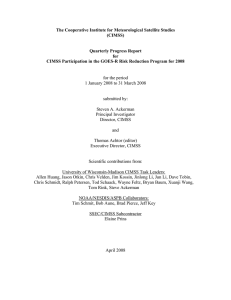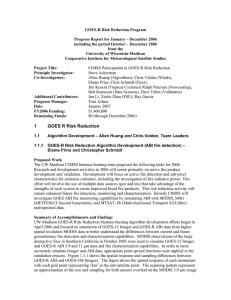CIMSS Participation GOES-R Proving Ground Status January 2011
advertisement
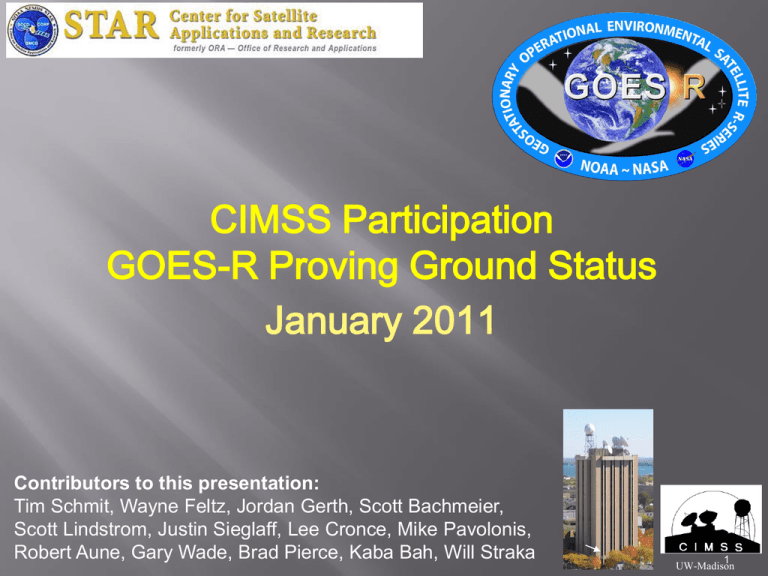
CIMSS Participation GOES-R Proving Ground Status January 2011 Contributors to this presentation: Tim Schmit, Wayne Feltz, Jordan Gerth, Scott Bachmeier, Scott Lindstrom, Justin Sieglaff, Lee Cronce, Mike Pavolonis, Robert Aune, Gary Wade, Brad Pierce, Kaba Bah, Will Straka 1 UW-Madison CIMSS PG Overview AWIPS Weather Event Simulator for the ABI final version being packaged future versions would be in AWIPS II AWIPS I and II status Demonstration of GOES-R AWG applications at Local NWS Offices Demonstration of GOES-R AWG applications at National Center Testbeds Near real-time NWP simulated ABI radiances Moved to new machine Faster (8X) NWP grid transfer 2 CIMSS PG Overview VISIT / Training GOES Sounder Derived Product Images M. Pavolonis visited the Centre for Australian Weather and Climate Research (CAWCR) at the Australian Bureau of Meteorology (BoM) Headquarters in Melbourne during the week of November 14, 2010. Forecast Products for the Pacific Region Up coming AMS annual meeting participation Oral and posters at the "First Conference on Transition of Research to Operations: Successes, Plans and Challenges“ and “Seventh Annual Symposium on Future Operational Environmental Satellite Systems” 3 UW-CIMSS PG Decision Support Summary The following list of products offers opportunity for near-real time Warning Related utility. Now Available – Orange, Near Future - Green Baseline Products: Volcanic Ash: detection & Height - Alaska, Pacific, and AWC Cloud and Moisture Imagery – All testbeds Hurricane Intensity - NHC Lightning Detection: Events, Groups & Flashes Rainfall Rate / QPE Total Precipitable Water - Pacific Fire/Hot Spot Characterization – HWT (Hydrologic and Fire) Option 2 Products: Aircraft Icing Threat – NASA LaRC, Bill Smith Jr Turbulence - AWC Convective Initiation (UWCI used where SATCAST not automated yet) Enhanced “V” / Overshooting Top Detection – HWT and HPC Low Cloud and Fog* – AWC and Alaska SO2 Detection – AWC and Alaska 4 * Uses cloud mask and cloud type as inputs GOES-R PG HWT Testbed • UWCI and Overshooting-top now processed GOES-11 (West), http://cimss.ssec.wisc.edu/snaap/convinit/quicklooks/ (select Hawaii or Western CONUS) • GOES Nearcasting output now available within AWIPS • Improved NSSL WRF time step data set transfer speed from NSSL to CIMSS from 45 minutes to 5 minutes • GOES Sounder SFOV stability indices GOES-R PG AWC Testbed Progress • UWCI, OTTC, Nearcasting available for integration • Volcanic ash, low cloud/fog, and SO2 feeds are coming on-line • GOES Nearcasting output now be available within AWIPS • Tests to occur January 2011– March 2011 • Training ? GOES-R PG Alaska/AAWU Testbed • MODIS Volcanic ash, SO2, low cloud/fog, cloud type/phase • All CIMSS related products (requested for testbed) are available to AAWC • Planning a attending Alaska mid-July OCONUS meeting in July GOES-R PG Pacific Testbed • UWCI now working in Hawaii domain, AWIPS integration ongoing • MODIS Volcanic ash ready for Alaska so Hawaii also • Working on GOES Sounder DPI for Hawaii • Direct broadcast antenna quote and tentative installation plan discussed, budget requested GOES-R PG Hydromet Prediction Center Testbed Participated in planning telcon on Monday December 6 Simulated ABI Imagery (bands 8-16) over the CONUS Hourly, using NSSL WRF LDM feed is being coordinated, will follow SPC delivery method GOES-R PG Ocean Prediction Center Testbed Participated in planning telcon on Monday December 7 Simulated ABI Imagery (bands 8-16) over the CONUS, follow HPC/SPC methodology for delivery, N-AWIPS preferred, SAB wanted McIDAS formatted, sent ADDE server info to Jamie K. Derived stability indexes (GOES Sounder SFOV) UW-CIMSS will provide overshooting-top/enhanced-V data (same methods as SPC delivery), training now available via Visitview and available for GOES-W Cloud pressure, height, and temperature not discussed but possible with GOES-R proxy algorithm (Andy Heidinger) http://cimss.ssec.wisc.edu/goes/blog/archives/7338 A comparison of the 1-km resolution POES AVHRR 10.8 µm IR image with the corresponding 4-km resolution GOES-13 IR image is a good demonstration of the problem of parallax error associated with viewing tall storm top features from geostationary satellites. Note how far northward the cloud features are displaced on the GOES-13 IR image. 8
